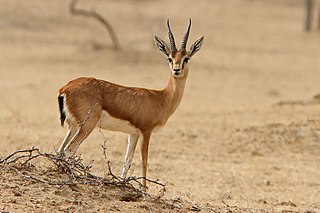Related Research Articles

The chinkara, also known as the Indian gazelle, is a gazelle species native to Iran, Afghanistan, Pakistan and India.

Thatta District is located in the southern area, locally called Laar, of the province of Sindh, Pakistan. Its capital is Thatta. It is home to a large necropolis of Makli. In 2013, several talukas were separated to form the new Sujawal District.
Astore Wildlife Sanctuary is as wildlife refuge located in Gilgit–Baltistan, Pakistan. It is within the Astore District, between Nanga Parbat 8,126 metres (26,660 ft) to the west and the plains of Deosai to the east, and about 11 km (6.8 mi) from the town of Bungi. Its area is approximately 414.72 km2 (160.12 sq mi) and its altitude is from 1,212 m (3,976 ft) to 6,060 m (19,880 ft).
Baltistan Wildlife Sanctuary is a wildlife sanctuary covering an area of 415 square kilometres in the Baltistan region of northern Pakistan. Contiguous with the Astore Wildlife Sanctuary to its south and east, the Baltistan Wildlife Sanctuary lies south of the Indus River, between the villages of Rondu and Shengus, in the Skardu District. This protected area was established in 1975, for the purpose of conserving the threatened species that occupy the park, and among them there are snow leopard, brown bear, lynx, Tibetan wolf, Tibetan sand fox, markhor, bharal, and Siberian ibex.
The Naltar Wildlife Sanctuary is a protected area located in the Naltar Valley near Nomal, in Gilgit-Baltistan, Pakistan. The Sanctuary was created on 22 November 1975 and consists of a steep-sided forested valley with high mountains on either side. A small number of Astor markhor are found here as well as other large mammals.
Gharo is a Town located in Thatta District, Sindh, Pakistan. Its population is about 2.000 families in 2017.
Karimpuzha National Park is a 230 km² proposed National Park located at 11°16′30″N76°25′25″E in the Nilgiri Hills area of Kerala and Tamil Nadu, in South India, IUCN category: PRO

Pulicat Lake Bird Sanctuary is a sanctuary for birds, 759 km2 in area, located in the Tirupati district of Andhra Pradesh and a protected area of the Thiruvallur District of Tamil Nadu, India. Pulicat Lake is the second largest brackish-water eco-system in India after Chilka lake in Orissa. The sanctuary's international name is Pulicat Lake Wildlife Sanctuary.
Zulfiqarabad, is a proposed new city in Thatta District, Sindh, Pakistan around 150 kilometers south-east from Karachi.

The Rann of Kutch is a large area of salt marshes that span the border between India and Pakistan. It is located in Gujarat, India, and in Sindh, Pakistan. It is divided into the Great Rann and Little Rann.

Sakteng Wildlife Sanctuary is a wildlife sanctuary in Bhutan, located in Merak and Sakteng Gewogs of Trashigang District and just crossing the border into Samdrup Jongkhar District. It is one of the country's protected areas and is listed as a tentative site in Bhutan's Tentative List for UNESCO inclusion.
The Bajwat Wildlife Sanctuary in Pakistan protects a complex of natural riverine habitats along the Chenab River and two of its tributaries, extending up to the border with India. Its total area of 5,400 hectares provides protection for waterfowl, as well as a variety of mammals including hog deer and nilgai. Scientists have recorded 110 species of birds on the site. The most common are species of the family Motacillidae. The sanctuary is in the Sialkot District.

Drigh Lake is situated in Qambar Shahdadkot District in Sindh, Pakistan, 29 kilometres (18 mi) from Larkana city and 7 kilometres (4 mi) from Qambar town. It has a surface area of 408 acres (165 ha) and the running length of the lake from North to South is about 5.64 Miles. Formed in the floods of 1814, 1815 and 1817.
Abubshahar Wildlife Sanctuary is situated in Sirsa district of Haryana state, India. It is spread over an area of 11530.56 hectares. It is 15 km away from Mandi Dabwali on the Dabwali-Sangariya road. Forests Department, Haryana of Government of Haryana officially notified this as Wildlife Sanctuary on 30 January 1987.
Saraswati Wildlife Sanctuary, also known as Seonsar Forest, is situated in Kaithal district of Haryana State, India. It is spread over an area of 4,452.85 hectares.
Manglot National Park or Manglot Wildlife Park is national park established in 1990 in Khyber Pakhtunkhwa, Pakistan; the park is provide a natural sanctuary for wildlife. The area of the park is spread over on 1,756 acres including hilltops and plain area near the Indus River in Nizampur, Nowshera.

The Baluchistan xeric woodlands ecoregion covers the middle elevations of a series of mountain ranges of western Pakistan and northeastern Afghanistan, reaching 1,200 kilometres (750 mi) from the Arabian Sea in the south to the Hindu Kush Mountains and the Himalayas in the north. The characteristic vegetation is xeric (dry) woodlands of shrubs and herbaceous cover. The region has rich biodiversity but relatively few endemic species.
References
- ↑ "Protected Area profile for Marho Kotri Wildlife Sanctuary". World Database on Protected Areas.